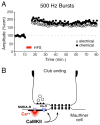Two independent forms of activity-dependent potentiation regulate electrical transmission at mixed synapses on the Mauthner cell
- PMID: 22771708
- PMCID: PMC4102419
- DOI: 10.1016/j.brainres.2012.05.059
Two independent forms of activity-dependent potentiation regulate electrical transmission at mixed synapses on the Mauthner cell
Abstract
Mixed (electrical and chemical) synaptic contacts on the Mauthner cells, known as Club endings, constitute a valuable model for the study of vertebrate electrical transmission. While electrical synapses are still perceived by many as passive intercellular channels that lack modifiability, a wealth of experimental evidence shows that gap junctions at Club endings are subject to dynamic regulatory control by two independent activity-dependent mechanisms that lead to potentiation of electrical transmission. One of those mechanisms relies on activation of NMDA receptors and postsynaptic CaMKII. A second mechanism relies on mGluR activation and endocannabinoid production and is indirectly mediated via the release of dopamine from nearby varicosities, which in turn leads to potentiation of the synaptic response via a PKA-mediated postsynaptic mechanism. We review here these two forms of potentiation and their signaling mechanisms, which include the activation of two kinases with well-established roles as regulators of synaptic strength, as well as the functional implications of these two forms of potentiation. Special Issue entitled Electrical Synapses.
Copyright © 2012 Elsevier B.V. All rights reserved.
Figures





Similar articles
-
Variability of distribution of Ca(2+)/calmodulin-dependent kinase II at mixed synapses on the mauthner cell: colocalization and association with connexin 35.J Neurosci. 2010 Jul 14;30(28):9488-99. doi: 10.1523/JNEUROSCI.4466-09.2010. J Neurosci. 2010. PMID: 20631177 Free PMC article.
-
Potentiation of electrical and chemical synaptic transmission mediated by endocannabinoids.Neuron. 2007 Dec 20;56(6):1034-47. doi: 10.1016/j.neuron.2007.11.014. Neuron. 2007. PMID: 18093525 Free PMC article.
-
Opioids potentiate electrical transmission at mixed synapses on the Mauthner cell.J Neurophysiol. 2015 Jul;114(1):689-97. doi: 10.1152/jn.00165.2015. Epub 2015 May 27. J Neurophysiol. 2015. PMID: 26019311 Free PMC article.
-
Dynamics of electrical transmission at club endings on the Mauthner cells.Brain Res Brain Res Rev. 2004 Dec;47(1-3):227-44. doi: 10.1016/j.brainresrev.2004.06.010. Brain Res Brain Res Rev. 2004. PMID: 15572174 Review.
-
CaMKII regulation in information processing and storage.Trends Neurosci. 2012 Oct;35(10):607-18. doi: 10.1016/j.tins.2012.05.003. Epub 2012 Jun 19. Trends Neurosci. 2012. PMID: 22717267 Free PMC article. Review.
Cited by
-
A calcium-dependent pathway underlies activity-dependent plasticity of electrical synapses in the thalamic reticular nucleus.J Physiol. 2017 Jul 1;595(13):4417-4430. doi: 10.1113/JP274049. Epub 2017 May 26. J Physiol. 2017. PMID: 28369952 Free PMC article.
-
Dopamine maintains network synchrony via direct modulation of gap junctions in the crustacean cardiac ganglion.Elife. 2018 Oct 16;7:e39368. doi: 10.7554/eLife.39368. Elife. 2018. PMID: 30325308 Free PMC article.
-
Gap junction plasticity as a mechanism to regulate network-wide oscillations.PLoS Comput Biol. 2018 Mar 12;14(3):e1006025. doi: 10.1371/journal.pcbi.1006025. eCollection 2018 Mar. PLoS Comput Biol. 2018. PMID: 29529034 Free PMC article.
-
Electrical synapses regulate both subthreshold integration and population activity of principal cells in response to transient inputs within canonical feedforward circuits.PLoS Comput Biol. 2019 Feb 25;15(2):e1006440. doi: 10.1371/journal.pcbi.1006440. eCollection 2019 Feb. PLoS Comput Biol. 2019. PMID: 30802238 Free PMC article.
-
Structural and Functional Consequences of Connexin 36 (Cx36) Interaction with Calmodulin.Front Mol Neurosci. 2016 Nov 18;9:120. doi: 10.3389/fnmol.2016.00120. eCollection 2016. Front Mol Neurosci. 2016. PMID: 27917108 Free PMC article.
References
-
- Alev C, Urschel S, Sonntag S, Zoidl G, Fort AG, Höher T, Matsubara M, Willecke K, Spray DC, Dermietzel R. The neuronal connexin36 interacts with and is phosphorylated by CaMKII in a way similar to CaMKII interaction with glutamate receptors. Proc Natl Acad Sci U S A. 2008;105:20964–9. - PMC - PubMed
-
- Alger BE. Retrograde signaling in the regulation of synaptic transmission: focus on endocannabinoids. Prog Neurobiol. 2002;68:247–86. - PubMed
-
- Barria A, Muller D, Derkach V, Griffith LC, Soderling TR. Regulatory phosphorylation of AMPA-type glutamate receptors by CaM-KII during long-term potentiation. Science. 1997;276:2042–5. - PubMed
-
- Bartelmez GW. Mauthner's cell and the nucleus motorius tegmenti. The Journal of Comparative Neurology. 1915;25:87–128.
Publication types
MeSH terms
Substances
Grants and funding
LinkOut - more resources
Full Text Sources
Miscellaneous

